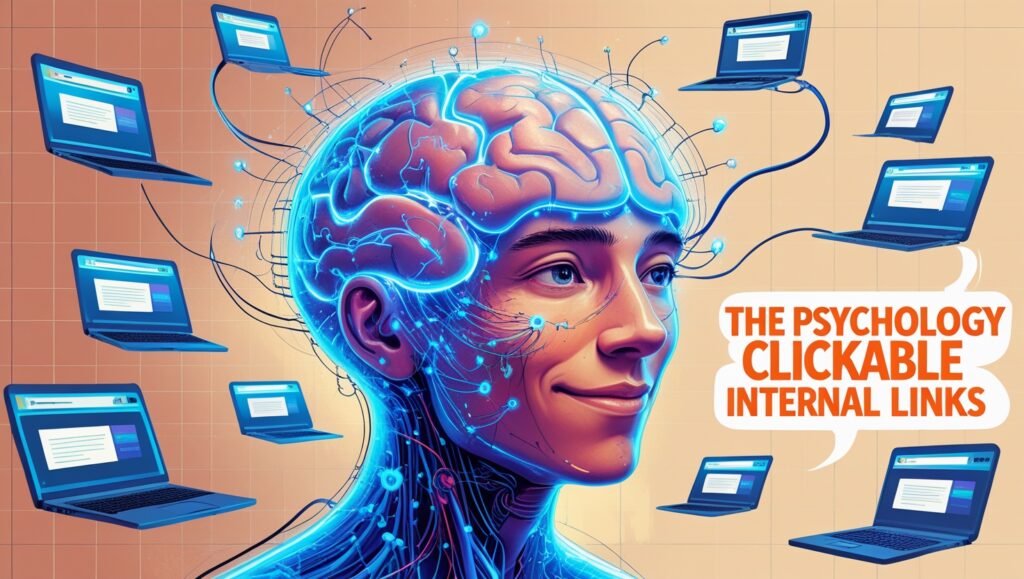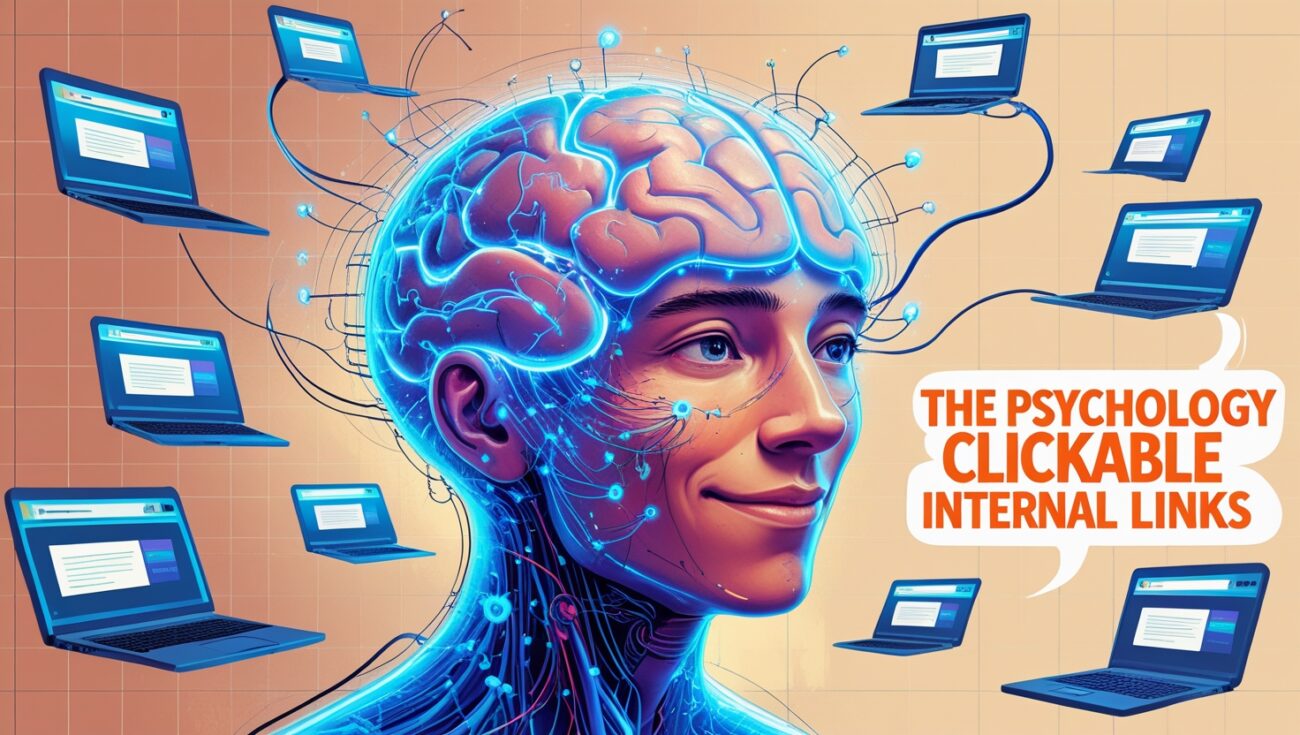The Psychology Behind Clickable Internal Links
We spend so much time in the SEO world talking about the technical aspects of internal links – how they pass link equity, improve crawlability, and build topical authority. But have you ever stopped to think about the human element?
Why do people actually click on some internal links and completely ignore others? Understanding the psychology behind a clickable link is the secret to not just improving your SEO, but also creating a more engaging and effective website right here in the USA.

Table of Contents
I’ve learned that a strategically placed internal link isn’t just a blue line of text; it’s a subtle invitation, a helpful suggestion, a promise of more value. By tapping into basic psychological principles, you can craft internal links that your readers are naturally drawn to click, leading to a better user experience, longer time on site, and ultimately, improved SEO metrics. Let’s dive into the fascinating psychology behind getting those clicks.
The Power of Curiosity and Information Gaps
One of the most powerful drivers of clicks is curiosity. We humans are naturally inquisitive, and we want to fill in gaps in our knowledge. When you create an internal link that hints at a related topic or promises to provide more detail on a point you’ve briefly touched upon, you pique the reader’s curiosity.
Example: Instead of a generic link like “read more,” try something like: “Curious about the common pitfalls to avoid? See our detailed guide here.” This phrasing creates a small information gap that the reader will be motivated to close by clicking the link.
Relevance and Context: Meeting the User’s Needs
For an internal link to be clickable, it needs to be highly relevant to the content the user is currently consuming. People click on links that they believe will help them achieve their goals or further their understanding of the topic at hand. Placing a link in the right context, at the precise moment the user might be seeking more information, significantly increases its click-through rate (CTR).
Example: If you’re writing about “the benefits of SEO for small businesses,” a contextual internal link to a page outlining your “affordable SEO packages for small businesses” is highly likely to be clicked by someone interested in taking the next step.
Clarity and Expectations: No Surprises, Please
Users appreciate clarity. They want to know what they’re clicking on and where it will take them. Vague or misleading anchor text can lead to hesitation and missed clicks. Your anchor text should clearly communicate the topic of the linked page, setting clear expectations for the user.
Example: Instead of a cryptic link like “find out,” use clear and descriptive anchor text such as “learn more about content marketing strategies for 2024.” This tells the user exactly what they will find if they click.
Visual Hierarchy and Link Placement
The way your internal links look and where they are placed on the page can also influence their clickability. Links that are visually distinct (using a different color or bolding) are more likely to be noticed. Placing links strategically within the flow of your content, particularly after you’ve made a key point or introduced a related concept, can also boost CTR.
Tip: Consider placing internal links within bullet points or at the end of paragraphs to make them stand out and feel like natural extensions of the information.
The Power of “Related Content” Suggestions
Many websites effectively use “Related Content” sections at the end of their articles. This taps into the user’s interest in the topic they just finished reading. By suggesting relevant articles with compelling titles, you’re essentially saying, “If you found this interesting, you might also like these.” This leverages the user’s existing engagement and encourages further exploration of your site.
Automation: Making Relevant Suggestions Effortless
Identifying all the psychologically optimal places to add internal links across a large website can be a daunting task. Automated internal linking software like Linkbot can analyze your content and suggest highly relevant linking opportunities based on semantic relationships and contextual relevance, helping you tap into these psychological triggers at scale. If you want to effortlessly enhance the clickability of your internal links, I highly recommend exploring Linkbot.
Conclusion: Clicking with Your Audience
Understanding the psychology behind why people click is just as crucial as understanding the technical aspects of internal links. By focusing on curiosity, relevance, clarity, visual cues, and leveraging the power of suggestion, you can craft internal links that your audience in the USA will be more inclined to click. This not only improves your SEO by keeping users engaged on your site longer but also helps you build a more valuable and effective online presence.
Start thinking beyond the blue link and consider the psychological triggers that drive clicks. It’s a subtle but powerful shift that can have a significant impact on your website’s success. Ready to connect with your audience on a deeper level? Discover how Linkbot can help you create more clickable internal links today.
Beyond the direct click-through rate, a smart internal linking strategy also taps into the principle of reciprocity. When you thoughtfully link to another one of your own pages that provides immense value to the reader, you’re essentially giving a small gift. You’re saying, “I’ve provided this great information, and here’s more to help you.” This builds a sense of trust and goodwill with the user, making them more likely to reciprocate by continuing to explore your site and become a loyal reader.
My journey taught me that a major mistake is thinking that SEO is just about external factors. I moved my focus from obsessing about what other websites were doing to obsessing about what I could control on my own website. These psychological “hacks” allowed me to feel like I was finally in the driver’s seat of my SEO, which was an empowering and exciting feeling.
The power of these psychological strategies is their compounding effect. Each time a user clicks a well-placed, thoughtful link, they are not only exploring more of your site but also reinforcing a positive mental model of your brand. Over time, this builds a strong, long-term relationship with your audience, making your website an increasingly powerful asset.
I’ve come to realize that a user’s journey through a website is a series of “promise-and-reward” loops. The title of an article promises value, and the content delivers it. A well-crafted internal link acts as the next promise, hinting at the reward of more information or a solution to a problem. When the user clicks and finds what they were looking for, the loop is completed, and their trust in your brand grows.
There’s a clear difference between a simple, obligatory link and one that has truly “earned the click.” The former is just there, part of the scenery. The latter is an irresistible call to action that’s been carefully crafted to tap into a user’s natural curiosity and desire for more information. That’s the difference between a website that just exists and one that truly engages its audience.
One of the greatest benefits I got from using an automated tool to manage my internal links was the “to-do” list it provided. Instead of being overwhelmed by the sheer size of my website, the tool gave me a prioritized, actionable list of connections to make. It transformed a monumental, frustrating task into a series of manageable steps that I could tackle in just minutes.
On the other side of the coin, broken or irrelevant links have a negative psychological impact. A link that leads to a 404 page or a page that doesn’t provide the promised value can instantly create a feeling of frustration and distrust. This is why a regular audit of your internal link profile is so crucial—it’s a direct way to build and maintain user confidence.
These psychological strategies are also a direct way to address Google’s E-E-A-T framework. By demonstrating a deep, interconnected network of valuable content, you are showcasing your expertise and authority. A website that is easy to navigate and provides a clear path for a user is a website that Google will reward with higher rankings.
I’ll never forget the satisfaction of using a tool to visualize a user’s journey through my website. I could see them land on an awareness-stage blog post, click a contextual internal link I had carefully placed, and then continue down the funnel toward a conversion. It was at that moment I realized my links weren’t just for SEO; they were actively guiding my audience.
A user’s mental model is a key consideration. They land on your site with a problem to solve or a question to answer. Your website’s structure should mirror their thought process, and your internal links are the tools that allow you to do that. They are the answers to the “what’s next?” questions your user is silently asking.
I felt like I was finally in the driver’s seat of my website. By mastering internal links, I was proactively building my site’s authority and user experience from the inside out, on my own terms, which was an empowering and exciting feeling. I realized that the best websites are the ones that are built with both the search engine and the human user in mind.
Ultimately, understanding the psychology behind clickable links is the secret to building a truly effective website. It’s the difference between a site that just has visitors and a site that has an engaged, loyal audience. By focusing on the human element, you can build a more valuable and profitable online presence.

